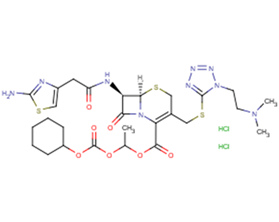
Cefotiam Hexetil Hydrochloride
CAS No. 95789-30-3
Cefotiam Hexetil Hydrochloride ( —— )
产品货号. M19841 CAS No. 95789-30-3
盐酸头孢替安是头孢替安的盐酸盐形式,是第三代半合成β-内酰胺头孢菌素抗生素,具有抗菌活性。
纯度: >98% (HPLC)
 COA
COA
 Datasheet
Datasheet
 HNMR
HNMR
 HPLC
HPLC
 MSDS
MSDS
 Handing Instructions
Handing Instructions
| 规格 | 价格/人民币 | 库存 | 数量 |
| 5MG | ¥583 | 有现货 |


|
| 10MG | ¥948 | 有现货 |


|
| 25MG | ¥1879 | 有现货 |


|
| 50MG | ¥2697 | 有现货 |


|
| 100MG | ¥4010 | 有现货 |


|
| 200MG | 获取报价 | 有现货 |


|
| 500MG | 获取报价 | 有现货 |


|
| 1G | 获取报价 | 有现货 |


|
生物学信息
-
产品名称Cefotiam Hexetil Hydrochloride
-
注意事项本公司产品仅用于科研实验,不得用于人体或动物的临床与诊断
-
产品简述盐酸头孢替安是头孢替安的盐酸盐形式,是第三代半合成β-内酰胺头孢菌素抗生素,具有抗菌活性。
-
产品描述Cefotiam Hydrochloride is the hydrochloride salt form of cefotiam a third-generation semi-synthetic beta-lactam cephalosporin antibiotic with antibacterial activity. Cefotiam binds to penicillin-binding proteins (PBPs) transpeptidases that are responsible for crosslinking of peptidoglycan. By preventing crosslinking of peptidoglycan cell wall integrity is lost and cell wall synthesis is halted.
-
体外实验——
-
体内实验——
-
同义词——
-
通路GPCR/G Protein
-
靶点Antibacterial
-
受体PBPs
-
研究领域Inflammation/Immunology
-
适应症Antibiotics
化学信息
-
CAS Number95789-30-3
-
分子量768.765
-
分子式C27H37N9O7S3.2ClH
-
纯度>98% (HPLC)
-
溶解度DMSO:130.1 Mm
-
SMILESCl.Cl.CC(OC(=O)OC1CCCCC1)OC(=O)C1=C(CSc2nnnn2CCN(C)C)CS[C@@H]2[C@H](NC(=O)Cc3csc(N)n3)C(=O)N12
-
化学全称——
运输与储存
-
储存条件(-20℃)
-
运输条件With Ice Pack
-
稳定性≥ 2 years
参考文献
1.Matsuda K et al. Antimicrob Agents ChemOthers. 1995 Dec;39(12):2631-4.
产品手册




关联产品
-
Buramate
Buramate 具有神经保护和抗惊厥活性。
-
N-(Ketocaproyl)-D,L-...
N-(Ketocaproyl)-D,L-homoserinelactone 是一种群体感应 (QS) 自诱导剂。
-
Rifamycin S
Rifamycin S 是一种有效的 DNA 依赖性 RNA 聚合酶抑制剂,是一种醌和针对革兰氏阳性菌的抗生素。



 021-51111890
021-51111890 购物车()
购物车()
 sales@molnova.cn
sales@molnova.cn







